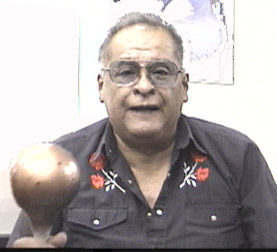Maap Echkeyuuw? Juan Meza Cuero Nyemii Echkwechyaaw
By Roy Cook
Maap Echkeyuuw? Who will sing? This is often an unvoiced thought at gatherings
in local tribal Tipai communities. Unvoiced because by custom and tradition
someone is approached and has accepted the responsibility to see that
the proper protocol and sequence are observed. Juan Meza Cuero is a Echkwechyaaw,
a singer of Nyemii (Wildcat, Gato) Tipai song. In his role as our teacher
he is adamant about establishing the historical character of these Wildcat
songs. Jon has often said, " I learned these songs from my Father when
I was seven years of age. At that time my father was 85 years of age.
He learned the songs from his father when his father was 85 years old.
I am now seventy-five. How many years is that?"
At first, I thought this was a rhetorical statement. Upon reflection I
can recognize my error in perception. One of the constant qualities I
have learned as a singer of tribal songs, and association with tribal
singers and lead singers in particular, is a sense of singer/song territoriality.
Many lead singers establish their 'credentials' to present their repertoire
by acknowledging their debt to those who taught them the songs. Juan is
a lead singer of Wildcat Tipai song.Currently, in this Southern California
region, there are respected Tribal elders who recall this Wildcat style
of singing and may have the ability to support the presentation, but will
not attempt a presentation without a lead singer. (I must respect their
choice to not be listed in public.)

Oral history is much more than just words. Emory Sekaquaptewa (a Hopi lawyer and tribal judge) says that for the Hopi, oral history is behavioral performance tied to symbols, music, singing, and place; it is not about telling campfire stories to children but about teaching them how to organize their everyday life. History is encoded in ritual. Therefore, if a people remain in their creation lands they will continue to detail events and orally weave a tightly woven basket holding those songs and stories, These songs and stories contain all that is necessary to define that Band tribe Nation. The oral tradition will provide the structure for the people to remember who they are, where they came from, and what has happened to them. If they move, they remember where they were and how they came to be where they are now. Our teacher, Juan Cuero has seen much in his lifetime. He lightly shares his knowledge and experiences. With his teaching and songs we see intuitions and feel emotions beyond our experience and expectations.
Historically there is most decidedly much visible changes in these California costal communities, populations, cultures economy and yet when the group is singing these songs. The gathering breathes with life and it seems as if the songs are given wing as they echo in the canyons. Finally, when the group sings our experience of the moment is as if, there and then, time as it is defined in the western world has no meaning. At these moments when we are in the song, we are the song. Very often we grasp experiences filled with emotion and physically we have felt our heart fill our chest as we sing, and sing again and again.
Roy Cook (Mazopiye Wichasha) Opata/Osage, author/publisher.
americanindiansource.com
SOUTHERN CALIFORNIA GOURD RATTLE CONSTRUCTION Click for Review